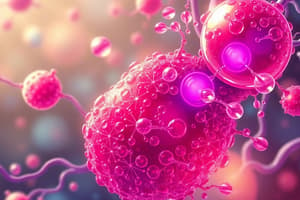Podcast
Questions and Answers
What is the primary function of the cell membrane?
What is the primary function of the cell membrane?
- Synthesizing proteins
- Separating the inside and outside of the cell (correct)
- Providing energy to the cell
- Storing genetic information
Homeostasis refers to the constant fluctuation of the internal environment in a living organism.
Homeostasis refers to the constant fluctuation of the internal environment in a living organism.
False (B)
List the four levels of organization in biological systems.
List the four levels of organization in biological systems.
Cells, tissues, organs, systems
The lipid bilayer consists of ______ that are embedded with various proteins.
The lipid bilayer consists of ______ that are embedded with various proteins.
Which type of chemical signaling is utilized for very close cell communication?
Which type of chemical signaling is utilized for very close cell communication?
What happens if there is no feedback during the homeostasis process?
What happens if there is no feedback during the homeostasis process?
Match the following types of chemical signaling with their characteristics:
Match the following types of chemical signaling with their characteristics:
The plasma membrane is composed of a ______ bilayer.
The plasma membrane is composed of a ______ bilayer.
Flashcards
Homeostasis
Homeostasis
The process of maintaining a stable internal environment.
Lipid bilayer
Lipid bilayer
A double layer of lipids forming the cell membrane.
Cell membrane
Cell membrane
The boundary that separates the inside of a cell from its surroundings.
Cell communication
Cell communication
Signup and view all the flashcards
Signal transduction
Signal transduction
Signup and view all the flashcards
Cellular receptors
Cellular receptors
Signup and view all the flashcards
Modes of chemical signaling
Modes of chemical signaling
Signup and view all the flashcards
Levels of biological organization
Levels of biological organization
Signup and view all the flashcards
Study Notes
Cellular Environment
- Four levels of organization exist: cells, tissues, organs, and systems.
- Homeostasis is crucial; it maintains a stable internal environment within a comfortable range. Fluctuations are undesirable.
- Homeostatic mechanisms use a feedback system:
- A disturbance from the desired state is detected.
- Input is measured.
- The controller processes the status/value.
- A command is sent to the effector.
- The effector responds to return the system to the set point.
- Feedback confirms whether the set point has been achieved.
- An example of homeostasis is a change in temperature. If a person burns their skin, the skin cells (system) will measure the change, send a message to the brain (controller), and the muscles (effectors) will respond by taking measures to restore homeostasis, like backing off (e.g., cooling).
- Failure in feedback mechanisms can lead to injury or illness.
- The lipid bilayer is a crucial component of cell membranes that maintains homeostasis.
Cell Membrane Structure and Function
- The cell membrane is a lipid bilayer surrounding a cell.
- The lipid bilayer is complex (heterogeneous) and comprises various molecules with roles such as structure, protection, and cell activation.
- The structure includes various proteins within the membrane with a diverse range of functions, which are essential for maintaining homeostasis.
- Examples include transport channels, enzymes, surface receptors, surface markers, and cytoskeleton attachment points.
Cell Communication
- Cells can communicate in three primary ways, based on the distance between communicating cells.
- Very close - Contact signaling or diffusion. Signaling molecules are exchanged directly.
- Medium range - One cell signals to another cell; signaling molecules bind to receptors on another cell.
- Very distant - A carrier protein transports signaling molecules to the target cell.
- Modes of chemical signalling depend on the distance between cells.
- Signal transduction pathways are involved in the communication process.
- Cellular receptors are vital for receiving and interpreting signals.
Studying That Suits You
Use AI to generate personalized quizzes and flashcards to suit your learning preferences.




